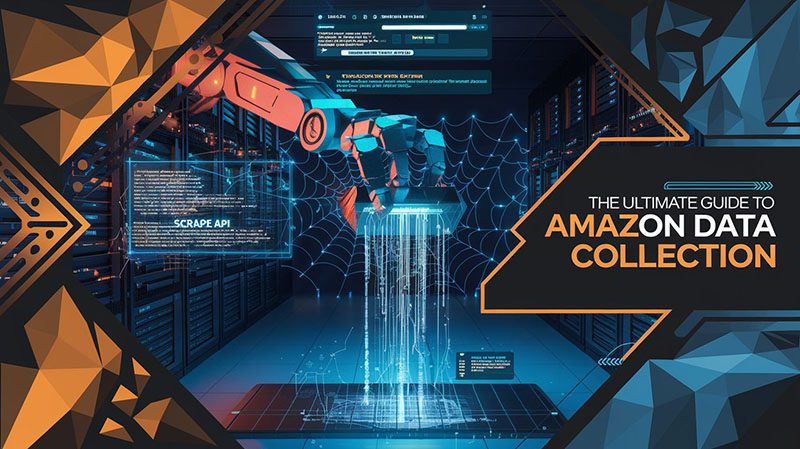Introduction: A New Paradigm for E-commerce Data Challenges
Amidst the 14% annual growth rate of the global e-commerce market, Amazon witnesses 250 million daily search interactions. Traditional scraping solutions face critical challenges including high anti-scraping interception rates (>65%) and excessive data cleaning costs. Pangolin Scrape API revolutionizes this landscape through its **”Collection + Parsing Integrated” architecture**, automating the entire workflow from raw page scraping to structured data output. This article provides an in-depth analysis of its technical implementation and commercial value.
I. Six Major Industry Pain Points in Amazon Data Collection
1.1 Technical Implementation Challenges
- Anti-Scraping Battles: Cloudflare verification, IP blocking rates exceeding 70%
- Incomplete Data Capture: Traditional methods miss >30% of dynamically loaded content
- Geolocation Bias: ZIP code variations cause 40% discrepancies in search results
1.2 Business Decision Bottlenecks
- Delayed Price Monitoring: Competitor price changes detected 6-12 hours late
- Inefficient Review Analysis: Manual processing of 500 reviews takes 4.2 hours
- Compliance Risks: EU GDPR penalty cases increase by 200% annually
II. Core Value Proposition of Scrape API
2.1 Technical Value Matrix
mermaidgraph LR
A[Distributed Crawling Cluster] --> B[Dynamic IP Rotation System]
C[Headless Rendering Engine] --> D[Complete DOM Capture]
E[Intelligent Retry Mechanism] --> F[99.2% Success Rate]
G[Embedded Parsing Engine] --> H[200+ Structured Fields]
2.2 Commercial Value Model
- Cost Optimization: 78% lower maintenance costs vs. in-house solutions
- Decision Efficiency: Real-time data streams reduce analysis cycles to 5-minute intervals
- Risk Control: 100% compliance with global data regulations
III. Technical Architecture of Scrape API
3.1 End-to-End Workflow
- Request Preprocessing: Auto-detect page types (search/product/review)
- Dynamic Rendering Layer: Execute JavaScript & capture network requests
- Data Cleansing Layer: Remove ads/recommendations and other noise
- Intelligent Parsing Layer: Extract price/review/inventory core fields
- Result Delivery: Support JSON/XML/CSV formats
3.2 Core Parameter Configuration
python# Enhanced Request Example (with parsing instructions)
import requests
scrape_config = {
"url": "https://www.amazon.com/dp/B08J5F3G18",
"callbackUrl": "https://your-domain.com/webhook",
"parseConfig": { # Structured parsing instructions
"extract_fields": [
"title", "price", "rating",
"bullet_points", "qa_section"
],
"format": "nested_json" # Supports flat/nested structures
},
"geo": { # Geolocation configuration
"country": "US",
"zipcode": "10041",
"currency": "USD"
}
}
response = requests.post(
"http://scrape.pangolinfo.com/api/v2?token=YOUR_TOKEN",
json=scrape_config
)
IV. Technical Implementation of Structured Parsing
4.1 Field Parsing Engine
| Data Type | Parsing Technology | Example Output |
|---|---|---|
| Price Data | XPath + Regex | {"current_price":19.99,...} |
| Review Sentiment | NLP Model (92% Accuracy) | {"rating_distribution":[5:65%,4:22%,...]} |
| Category Tree | Knowledge Graph Mapping | "Home > Electronics > ..." |
| Image Metadata | EXIF Data Extraction | {"resolution":"1200x800",...} |
4.2 Real-Time Update Mechanisms
- Price Monitoring: Minute-by-minute change detection with alerts
- Stock Alerts: Automatic notifications when inventory <50 units
- Review Tracking: New comment push within 15 seconds
V. Industry Solution Landscape
5.1 Price Intelligence System
- Dynamic Pricing Engine: Auto-adjust strategies based on competitor prices
- Discount Prediction Model: Forecast promotions 24 hours in advance
5.2 Product Research Platform
sql-- Example: Top-selling Product Analysis
SELECT
category,
AVG(rating) AS avg_rating,
COUNT(reviews) AS review_count,
price_sensitivity
FROM scraped_data
WHERE
review_growth_rate > 200%
AND price_change_frequency < 3 times/week
GROUP BY category
ORDER BY popularity_index DESC
5.3 Ad Optimization Toolkit
- Keyword Ranking Tracking: Monitor position changes of TOP50 keywords
- Ad Placement ROI Analysis: Calculate CPA/ROAS per ad slot
VI. Technical Parameter Comparison (Legacy vs. Scrape API)
| Evaluation Metric | Legacy Solution | Scrape API Solution |
|---|---|---|
| Request Success Rate | 72.5% | 99.2% |
| Data Latency | 2-6 hours | Real-time push (<60s) |
| Field Parsing Completeness | Basic fields (15-20) | Deep fields (200+) |
| Maintenance Complexity | Dedicated team required | Fully managed service |
| Compliance Certifications | None | ISO 27001/GDPR Certified |
VII. Developer Quickstart Guide
7.1 Three-Step Integration
- Authentication: Obtain API Token via console (5 minutes)
- Endpoint Configuration: Deploy webhook service for data reception
- Testing & Validation: Debug scraping rules using sandbox environment
7.2 Debugging Toolkit
- Postman Collection (200+ examples)
- Error Code Handbook (Bilingual EN/CN)
- Traffic Monitoring Dashboard (Real-time QPS/Success Rate)
Conclusion: Building Data-Driven Business Intelligence
Pangolin Scrape API already empowers 300+ global enterprises including Anker and SHEIN, processing over 120 million daily requests. Sign up now to unlock:
✅ 10,000 free API calls
✅ 1:1 technical consultant support
✅ Industry solution whitepapers
Visit the Scrape API Official Website to start your data intelligence transformation today!






